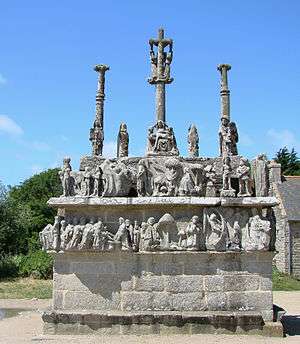Calvary (sculpture)

A calvary (calvaire in French) is a type of monumental public crucifix, sometimes encased in an open shrine, most commonly found across northern France from Brittany east and through Belgium and equally familiar as wayside structures provided with minimal sheltering roofs in Italy and Spain. The Breton calvaire is distinguished from a simple crucifix cross by the inclusion of three-dimensional figures surrounding the Crucifixion itself, typically representing Mary and the apostles of Jesus, though later saints and symbolic figures may also be depicted.
In northern France and Belgium, such wayside calvaries erected at the junction of routes and tracks "function both as navigation devices and objects of veneration", Nicholas J. Saunders has observed[1] "Since medieval times they have fixed the landscape, symbolically acquiring it for the Christian faith, in the same way that, previously, Megalithic monuments marked prehistoric landscapes according to presumed religious and ideological imperatives".
The oldest surviving calvaire is at the Chapelle Notre-Dame-de-Tronoën in the town of Saint-Jean-Trolimon, in south Finistère, near the Pointe de la Torche. This is raised on a large base which also includes carved representations of the Last Supper and scenes from the passion. Calvaires played an important role in Breton pilgrimages known as Pardons, forming a focal point for public festivals. In some instances the Calvary forms part of an outdoor pulpit or throne.
Calvaires are to be found in large numbers throughout Brittany, and come in many varied forms.[2]
A 16th-century calvaire from Louargat, Brittany, transplanted to serve as a World War I memorial, stands at the Carrefour de la Rose near the Belgian town of Boezinge north of Ypres.[3] The most notable Calvary monument outside Brittany is at Lourdes. This was specifically intended to represent Breton Catholicism. It was created by the sculptor Yves Hernot in 1900 as a gift to Lourdes from the main Breton dioceses: Rennes, Vannes, Quimper and Saint-Brieuc.[4][5] The monument comprises a single central cross set within a raised square base at each corner of which a statue of one of the witnesses to the crucifixion is placed.
Gallery
-
The Breton Calvary at Lourdes designed by Yves Hernot.
-

15th-century calvaire at Notre-Dame de Tronoën, Brittany.
-

The calvaire at St Jean Trolimon, in Finistère
-

Calvaire at Saint-Tugen Chapel, Primelin, Brittany (second half of the 16th century).
-

Calvaire in Pleubian.
-
Calvary of Protest in Tréguier
-

Paul Gauguin's painting The Green Christ, depictring the Calvary of Névez
-
Calvary at Castro Barbudo, Galicia
-
Cruceiro at Portomarín, Galicia
See also
- High cross, British sculptures
- Russian Calvary cross
References
- ↑ Saunders, "Crucifix, Calvary, and Cross: Materiality and Spirituality in Great War Landscapes", World Archaeology 35.1, The Social Commemoration of Warfare (June, 2003:7-21), p. 9.
- ↑ New York Times, Brittany's Church Towns Harris, AP, October 16, 1994
- ↑ Saunders 2003:10 and illus.
- ↑ Lourdes Official Website
- ↑ Don Sharkey, After Bernadette: The Story of Modern Lourdes, Kessinger Publishing, 2005, p.92.



